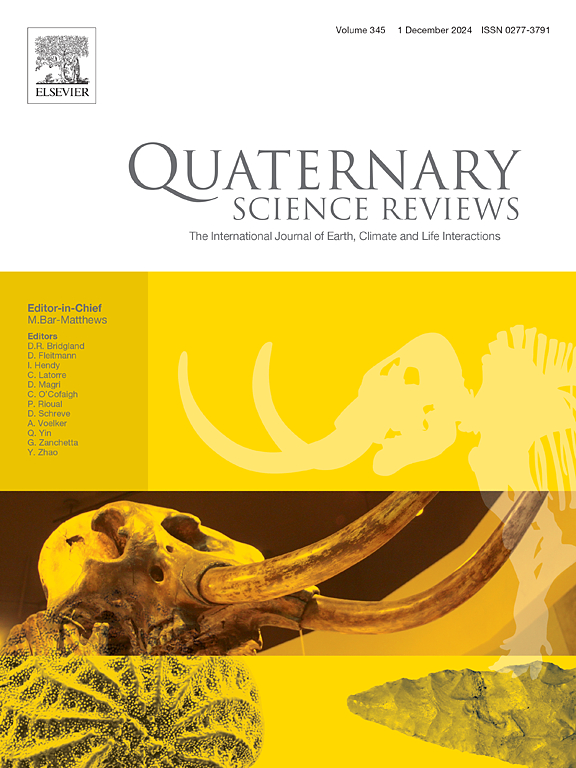近千年三江源区气候干旱化及其驱动机制
IF 3.2
1区 地球科学
Q1 GEOGRAPHY, PHYSICAL
引用次数: 0
摘要
由于三江源地区的水文气候变化影响着亚洲主要河流(长江、黄河和湄公河)的流量,下游地区和国家面临着日益严重的农业、生物多样性和水安全威胁。分析全新世晚期的水文气候变化,作为现代变暖模拟,可以为预测水系统对全球气温上升的反应提供关键见解。黄河和湄公河源区从中世纪暖期到小冰期都出现了普遍的干旱趋势。然而,长江源区几乎占三江源区面积的一半,却没有显示出这种格局的确凿证据,这凸显了进一步研究解决这种空间不一致性的紧迫性。在有机碳和碳酸盐含量指标的帮助下,利用塞勇Co沉积岩心的稳定碳氧同位素和粒度分布,重建了1700年来长江源区的区域水文气候变化。我们的新记录揭示了长江源区在过去一千年的区域干旱趋势,与周围地区的记录一致。具体而言,赛永错的水文气候历史表现为三个不同的阶段:公元200年至1100年相对湿润,公元1100年至1850年相对干燥,公元1850年以来转向明显湿润。通过将这些记录与已建立的气候和热带符号记录进行比较,探讨了千年趋势和百年时间尺度上区域水文气候变化的驱动机制。千年干旱趋势在很大程度上可归因于印度夏季风的逐渐减弱,而过去千年百年尺度的水文气候变化与ENSO事件一致。自1850年以来,季风降水加剧和气温上升表明长江源区向湿润条件过渡,这一转变需要进一步的监测和调查。这些发现为评估气候变化对长江源区长期生态可持续性的影响奠定了重要的基础。本文章由计算机程序翻译,如有差异,请以英文原文为准。
Climatic aridification and its driving mechanism in the Three-River Source Region over the past millennium
As hydroclimatic changes in the Three-River Source Region affect the streamflow of Asia's major rivers, i.e., the Yangtze, Yellow, and Mekong Rivers, downstream regions and nations face escalating threats to agriculture, biodiversity, and water security. Analyzing hydroclimatic changes during the late Holocene, as a modern warming analog, could provide key insights for forecasting water system responses to rising global temperatures. A general drying trend spanning the Medieval Warm Period to the Little Ice Age has been observed in both Yellow River and Mekong River Sourced Regions. However, the Yangtze River Source Region, which nearly covers half the Three-River Source Region, shows no conclusive evidence of this pattern, highlighting the urgency of further studies to resolve this spatial inconsistency. Here, with the assistance of proxies from organic carbon and carbonate contents, we used stable carbon and oxygen isotopes, and grain size distribution from a sedimentary core in Saiyong Co, to reconstruct regional hydroclimatic changes of the Yangtze River Source Region over the past 1700 years. Our new records reveal a regional aridity trend over the past millennium in the Yangtze River Source Region, consistent with records from surrounding regions. Specifically, Saiyong Co's hydroclimatic history is characterized by three distinct phases: relatively wet conditions from AD 200 to AD 1100, relatively dry conditions from AD 1100 to AD 1850, and a shift towards significantly wet conditions since AD 1850. By comparing these records with well-established climatic and tropical symbolic records, we probe the mechanism driving regional hydroclimatic changes across millennial trend and centennial timescales. The millennial drying trend can be largely attributed to the gradual weakening of the Indian Summer Monsoon, while centennial-scale hydroclimatic variations over the past millennium aligns with ENSO events. Since AD 1850, intensified monsoon precipitation and rising temperatures suggest a transition towards wetter conditions in the Yangtze River Source Region, a shift that demands further monitoring and investigation. These findings establish a vital baseline for evaluating climate change impacts on the Yangtze River Source Region's long-term ecological sustainability.
求助全文
通过发布文献求助,成功后即可免费获取论文全文。
去求助
来源期刊

Quaternary Science Reviews
地学-地球科学综合
CiteScore
7.50
自引率
15.00%
发文量
388
审稿时长
3 months
期刊介绍:
Quaternary Science Reviews caters for all aspects of Quaternary science, and includes, for example, geology, geomorphology, geography, archaeology, soil science, palaeobotany, palaeontology, palaeoclimatology and the full range of applicable dating methods. The dividing line between what constitutes the review paper and one which contains new original data is not easy to establish, so QSR also publishes papers with new data especially if these perform a review function. All the Quaternary sciences are changing rapidly and subject to re-evaluation as the pace of discovery quickens; thus the diverse but comprehensive role of Quaternary Science Reviews keeps readers abreast of the wider issues relating to new developments in the field.
 求助内容:
求助内容: 应助结果提醒方式:
应助结果提醒方式:


